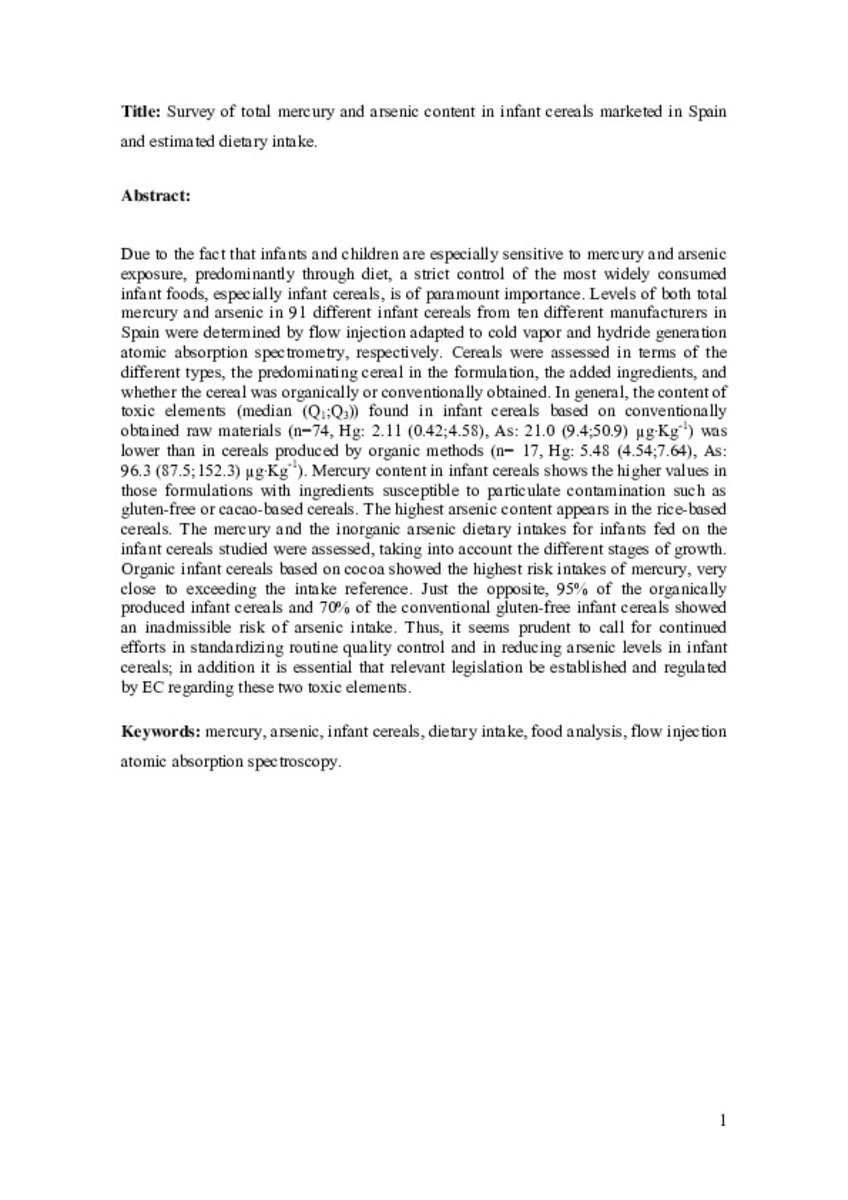Full metadata record
| DC Field | Value | Language |
|---|---|---|
| dc.creator | Navarro-Blasco, I. (Iñigo) | - |
| dc.creator | Raquel | - |
| dc.date.accessioned | 2017-12-14T17:08:39Z | - |
| dc.date.available | 2017-12-14T17:08:39Z | - |
| dc.date.issued | 2013 | - |
| dc.identifier.citation | Navarro, I. (Iñigo); Hernandez-Martinez, R. (Raquel). "Survey of total mercury and arsenic content in infant cereals marketed in Spain and estimated dietary intake." Food Control; 2013, 30(2):423-432 | es |
| dc.identifier.uri | https://hdl.handle.net/10171/45023 | - |
| dc.description.abstract | Due to the fact that infants and children are especially sensitive to mercury and arsenic 7 exposure, predominantly through diet, a strict control of the most widely consumed 8 infant foods, especially infant cereals, is of paramount importance. Levels of both total 9 mercury and arsenic in 91 different infant cereals from ten different manufacturers in 10 Spain were determined by flow injection adapted to cold vapor and hydride generation 11 atomic absorption spectrometry, respectively. Cereals were assessed in terms of the 12 different types, the predominating cereal in the formulation, the added ingredients, and 13 whether the cereal was organically or conventionally obtained. In general, the content of 14 toxic elements (median (Q1;Q3)) found in infant cereals based on conventionally obtained raw materials (n=74, Hg: 2.11 (0.42;4.58), As: 21.0 (9.4;50.9) μg·Kg-1 15 ) was 16 lower than in cereals produced by organic methods (n= 17, Hg: 5.48 (4.54;7.64), As: 96.3 (87.5;152.3) μg·Kg-1 17 ). Mercury content in infant cereals shows the higher values in 18 those formulations with ingredients susceptible to particulate contamination such as 19 gluten-free or cacao-based cereals. The highest arsenic content appears in the rice-based 20 cereals. The mercury and the inorganic arsenic dietary intakes for infants fed on the 21 infant cereals studied were assessed, taking into account the different stages of growth. 22 Organic infant cereals based on cocoa showed the highest risk intakes of mercury, very 23 close to exceeding the intake reference. Just the opposite, 95% of the organically 24 produced infant cereals and 70% of the conventional gluten-free infant cereals showed 25 an inadmissible risk of arsenic intake. Thus, it seems prudent to call for continued 26 efforts in standardizing routine quality control and in reducing arsenic levels in infant 27 cereals; in addition it is essential that relevant legislation be established and regulated 28 by EC regarding these two toxic elements. | es_ES |
| dc.language.iso | eng | es_ES |
| dc.rights | info:eu-repo/semantics/openAccess | es_ES |
| dc.subject | Mercury | es_ES |
| dc.subject | Arsenic | es_ES |
| dc.subject | Infant cereals | es_ES |
| dc.subject | Dietary intake | es_ES |
| dc.subject | Food analysis | es_ES |
| dc.subject | Flow injection 31 atomic absorption spectroscopy | es_ES |
| dc.title | Survey of total mercury and arsenic content in infant cereals marketed in Spain and estimated dietary intake. | es_ES |
| dc.type | info:eu-repo/semantics/article | es_ES |
Files in This Item:
Statistics and impact
Items in Dadun are protected by copyright, with all rights reserved, unless otherwise indicated.






